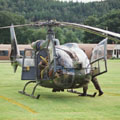Ready for liftoff
- 4 April 2006
 Jon Hoeksma
Jon Hoeksma
While the NHS struggles to enable clinicians’ access to electronic patient records from different English hospitals, the UK Defence Medical Services (DMS) is about to begin implementing a system that will enable the medical records of armed forces personnel to be accessed anywhere in the world British armed forces are deployed.
Later this month, the MOD is due to choose between two competing consortia led by IBM and Logica CMG. Both are offering systems largely based on EMIS’s PCS clinical software system, which have been extensively trialled and tested over the past 12 months. The new system will replace EMIS LV, currently used by the armed forces, will provide worldwide access to medical records.
The Defence Medical Information Capability Programme (DMICP), which began in 2002, will “create a single database that will hold an integrated healthcare record, similar to the detailed healthcare record in NPfIT,” according to Colonel Mike Manson, assistant director of medical information management, Defence Medical Services Department, at the MoD.
Speaking at Healthcare Computing 2006 last month, Col. Manson added that the DMICP system will use the highly secure Defence information infrastructure, including military communication satellites, to “provide secure access Worldwide”. In addition, the colonel said the new system would include “very robust access controls”.
Smart dog tags
|
"Size-wise we’re roughly the size of a PCT, but geographically we’re basically global" — Colonel Mike Manson, assistant director of medical information management, Defence Medical Services Department
|
For situations in which communications are not adequate, the system will make use of ‘personal information carriers’ in the form of a “ruggedised chip” – a form of smart dog tag. The point, stressed, Col. Manson was to ensure there was “multiple redundancy of storage of data”.
The new MOD medical records system will provide detailed electronic patient records for about 250,000 serving members of the armed services and their families, and eventually integrate with the NHS Care Records Service (NHS CRS). About 7,000 defence medical staff and up to 3,000 medical reservists will ultimately be able to use the system to provide health services and care to armed forces personnel wherever the British Army, Royal Navy and Royal Air Force is serving internationally.
“Size-wise we’re roughly the size of a PCT, but geographically we’re basically global,” said Col. Manson. He illustrated the point by highlighting current deployments, which include field hospitals in Iraq and Afghanistan, UN operations together with the medical facilities “aboard the large number of HM navy ships”.
Integration with NHS electronic records will be vital as the Ministry of Defence no longer maintains any dedicated services hospitals, relying instead on the NHS for all secondary care. “We have a very strong reliance on the NHS and therefore NPfIT,” said Col Manson.
The 6th LSP
He said that due to the similarity of many of the challenges and links to the NHS and NPfIT, the DMICP was in many ways the “virtual sixth Local Service Provider (LSP)” – a reference to the five prime contractor deals for delivery of the NHS IT programme.
Despite this very close reliance on the NHS the colonel, a former artillery officer, explained that an early decision was taken by the MOD not to participate in NPfIT. Instead the armed forces’ programme will in essence be producing its own detailed medical record, analogous to the detailed record envisaged as part of NHS CRS.
When fully implemented, the intention is that someone recruited into the armed forces will have their NHS CRS record imported into the military system, and the full record will be exported back out into NHS CRS upon their discharge. The electronic military medical record will be able to hold small diagnostic images.
“We currently use EMIS LV in all of our medical centres, but paper is still the prime record,” said Col. Manson. He explained that particular challenges included “a highly mobile population”, which moves every 2-3 years, and “people can expect to go on six month operations”.
He explained that currently when the army goes on active operations, “we take ruggedised laptops pre-loaded with data for that particular unit.” A solution that he said was less than perfect as individuals are often assigned to units or moved at short notice, or a medical team may often have to treat military and civilian personnel outside of a particular unit.
Better sharing of information
|
"By involving future users you get the highest chance of getting the solution right" — Colonel Mike Manson
|
Describing the capability gaps currently faced, the colonel said: “Our main limitation is sharing information… Access to medical records is on a local basis not enterprise-wide”.
He added that ‘casualty regulation’ was “something we clearly need to do far better than we do at the moment.”
The other major gap he pointed to was epidemiology. “As we have no central database it’s not easy to monitor disease or monitor disease spread.” One of the key requirements for any military commander was to ensure that they had a clear picture of the fighting strength of a particular unit. Col. Manson added that the lack of a central database also made it very difficult to do research effectively.
Col. Manson said that the new system will “help significantly reduce the length of care pathways” and ensure that military care is truly integrated and connected, from the soldier in the field “all the way through to the NHS”.
The new system is due to be fully implemented by 2010, with early operating capability (EOC) in place by Autumn 2006 – followed by a four year roll out. The EOC phase is intended to deliver over 80% of capabilities early in the programme.
Minimising risk
Following the launch of the programme in 2002, by the end of 2003 two consortia led by IBM and Logica CMG offering commercial ‘off the shelf’ products had been left in contention. “We didn’t specify what products we wanted but left that to them [the prime contractors] to decide,” said Manson.
To minimise risks, 2004 was then dedicated to “a risk reduction phase for a full year”. During this period the suppliers were “paid to develop their knowledge”.
Final selection is to be done on a risk evaluation basis “without sight of costs”, the colonel said. He added that the importance of the project was reflected by the seniority of the officers leading the project, with both the Surgeon General and Head of the Defence Medical Staff on the programme board.
Speaking of lessons learned the colonel said: “Change is inevitable and essential, wide consultation is essential but it’s probably unwise to try and speak to everyone.” He added: “By involving future users you get the highest chance of getting the solution right.”
He also advised anyone starting an electronic records project to “start business change work as soon as possible, as this help avoid the piftfall of IT driving the business.”
He concluded: “These lessons provide an interesting comparison with media reports of the national programme over the past three years.”




